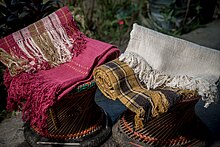Eri silk in Meghalaya
This article has multiple issues. Please help improve it or discuss these issues on the talk page. (Learn how and when to remove these messages)
|
Eri silk, a prized fabric woven from the cocoons of domesticated silkworms, holds a special place in the rich cultural heritage of Meghalaya, a state in northeastern India. It is a traditional art inherited from generation to generation and treated as a means of occupation, making the clusters self sustaining communities.[1]

Weaving with Eri Silk "Ryndia" in Meghalaya
[edit]Made from the domesticated silkworm Samia Cynthia Ricini, Eri Silk, locally known as Ryndia, is a traditional fabric woven by the tribes of Meghalaya. Ryndia[2] derives its name from the Castor leaves called 'Rynda,' which serve as the primary food source for the silkworms.[citation needed]
The Ri-Bhoi District is region in Meghalaya where Eri culture[3] and handloom weaving[4] continue to thrive. Weaving with Eri silk[5] is an integral part of the district's culture and heritage, handed down through generations. Exclusively carried out by women, the process involves spinning and weaving using traditional tools such as the Takli and other handmade devices. The entire value chain,[6] including silkworm rearing, application of natural dyes, and weaving, takes place within the state. Women in Meghalaya actively engage in the rearing and weaving of Eri Silk, making it a household activity exclusively conducted by them.[citation needed]
Eri Silk, commonly referred to as 'Peace Silk'[7] or the 'Fabric of Peace,[8]' is named so due to the non-violent method of silk extraction practised for generations in Meghalaya, which does not harm or kill the silkworms. This unique silk variant possesses a thicker texture and exhibits wool-like characteristics. Ryndia, known for its durability, surpasses other silk fabrics, making it an heirloom[9] material passed down through generations in Meghalaya. A distinguishing feature of Ryndia woven in Meghalaya is its 100% natural dyeing process,[10] using plants and plant parts such as turmeric, onion skins, and plant-based mordants like Sohkhu and Soh tung. These dyeing techniques are exclusively practised by weavers in Ri-Bhoi,[11] Meghalaya.[citation needed]
Ri-Bhoi District serves as the epicentre of Eri Silk weaving[12] in Meghalaya and is among the various regions where Eri culture and handloom weaving are deeply rooted in tradition.[13] The process of spinning and weaving Eri silk is exclusively carried out by women,[14] employing traditional tools such as the Takli and other handmade implements.
Meghalaya, particularly the weavers from Ri-Bhoi District, employs environmentally friendly methods by utilizing natural ingredients for dyeing Eri Silk.[15] These ingredients include flowers, leaves, vegetable peels, and tree bark, which are collected by women weavers from nearby forests. Traditionally, the artisans primarily utilise three main colours: Lac for red, turmeric for yellow, and black which is derived from iron ore. However, through training provided by government initiatives and non-governmental organizations, artisans have expanded their range of colours.[1]
What distinguishes the natural dyeing[16] process in this region is the utilization of natural dye fixatives or mordants that help the natural colours adhere to the yarn. Some examples of these natural mordants include Sohkhu tree leaves (Baccaurea ramiflora lour), tree bark of Diengrnong (local name), Sohtung leaves (Terminalia chebula retz), and others.
The weavers of Ri-Bhoi have recorded the use of thirty-three plant species for creating natural organic colours[17] to dye Eri-silk yarns. These dyestuffs and mordants are obtained from locally available plants and plant parts, such as leaves, bark, fruits, stems, and peels. Most of these plants are naturally grown, while some are cultivated in the weavers' backyards specifically for colour extraction.[citation needed]
In recognition of the significance of the traditional weaving of Eri Silk and natural dyeing Umden in Meghalaya, the Department of Textiles declared Diwon, Raid Nongtluh, located in Ri-Bhoi, as the State's first Eri Silk Village[18] on February 12, 2021.
References
[edit]- ^ a b Nisa Lyndem:Dr. Nisaphi Lyndem; Garland Magazine Australia
- ^ "Ryndia - Eri Silk of the Khasi Hills". Selvedge Magazine,United Kingdom. 2021-04-17. Retrieved 2023-06-23.: Dr. Nisaphi Lyndem
- ^ Nath, Gopika (2017-03-02). "garam masala chai: Exploring My Textile Obsession with Eri Silk of Meghalaya, Guest Post by Anna-Louise Meynell". garam masala chai. Retrieved 2023-06-23.
- ^ "Weaving Freedom in Meghalaya". Google Arts & Culture. Retrieved 2023-06-23.
- ^ "Silken Tales From the Khasi Hills". The Wire. Retrieved 2023-06-23.
- ^ North East Slow Food & Agrobiodiversity Society, NESFAS. "Vale Chain of Eri Silk Ryndia in Ri-Bhoi Meghalaya" (PDF). Vale Chain of Eri Silk Ryndia in Ri-Bhoi Meghalaya.
- ^ Das, Tina (2022-11-06). "'Guilt-free' silk—this Meghalaya Eri silk village is tourist hotspot where weaving is sacred". ThePrint. Retrieved 2023-06-23.
- ^ "Eri Silk: Fabric of Peace". PeepulTree. 2021-06-18. Retrieved 2023-06-23.
- ^ "Handloom in Meghalaya: A symbol of the state's rich & varied cultural heritage". thenortheasttoday.com. 2021-08-07. Retrieved 2023-06-23.
- ^ "Natural Dyeing at UMDEN". www.bandhej.com. Retrieved 2023-06-23.
- ^ "Eri Silk Village – Meghalaya Tourism". Retrieved 2023-06-23.
- ^ "Eri Silk With Khneng Embroidery: A story from Meghalaya". www.tfod.in. Retrieved 2023-06-23.
- ^ annaloom (2019-05-30). "Eri Silk in Meghalaya: The humble heritage of the floor loom". annaloom. Retrieved 2023-06-23.
- ^ PUBLIC (2022-01-29). "Eri Silk Industry: A pathway to Atmanirbhar Bharat". The Shillong Times. Retrieved 2023-06-23.
- ^ Banerjee, Ashis Narayan; Kotnala, O.P.; Maulik, Sankar Roy (April 2018). Dyeing of Eri silk with natural dyes in presence of natural mordants. Indian Journal of Traditional Knowledge. pp. Vol. 17(2), April 2018, pp. 396–399.
- ^ "Natural Dyeing at UMDEN". www.bandhej.com. Retrieved 2023-06-26.
- ^ "dyeing – Ahimsa Eri Silk". Retrieved 2023-06-26.
- ^ NEWS, NE NOW (2021-02-13). "Meghalaya's Umden –Diwon declared as first 'Eri Silk Village' in state". NORTHEAST NOW. Retrieved 2023-06-26.
